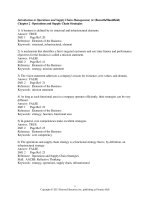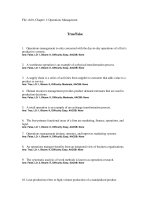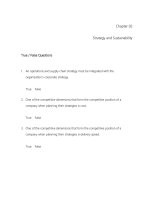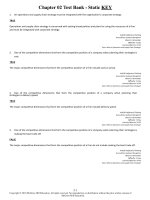Lecture Operations and supply chain management: The Core (3/e) – Chapter 9: Material requirements planning
Bạn đang xem bản rút gọn của tài liệu. Xem và tải ngay bản đầy đủ của tài liệu tại đây (745.19 KB, 15 trang )
Material Requirements
Planning
Chapter 09
McGrawHill/Irwin
Copyright © 2013 by The McGrawHill Companies, Inc. All rights reserved.
Learning Objectives
1.
2.
3.
4.
Describe what MRP is and where it is best
applied.
Understand the source of the information
used by the system.
Demonstrate how to do an MRP “explosion.”
Explain how order quantities are calculated in
MRP systems.
92
Enterprise Resource Planning
(ERP) and Material Requirements
Planning (MRP)
93
Material Requirements Planning
(MRP)
The logic that ties production functions
together from a material planning and control
view.
A logical, easily understood approach to the
problem of managing the parts, components,
and materials needed to produce end items
How much of each part to obtain?
When to order or produce the parts?
Dependent demand is drives the MPR system
94
Master Production Scheduling
The master schedule deals with end items and is a
major input to the MRP process
All production systems have limited capacity and
limited resources
The aggregate plan provides the general range of operation,
the master scheduler must specify exactly what is to be
produced
To determine an acceptable feasible schedule to be
released to the shop, trial master production
schedules are tested using the MRP program
95
Master Production Scheduling
Aggregate plan shows
overall quantities to
produce – without
specifying type
Week
MPS shows quantities
of each type, with
information about the
production time frame
96
MRP System Structure
MRP
system
inputs
MRP
system
outputs
97
Product Demand Sources
Customers – specific orders placed by either
external or internal customers
Aggregate production plan – the firm’s strategy
for meeting demand in the future,
implemented through the master production
schedule (MPS)
98
Bill of Materials (BOM)
99
MRP Explosion Process
910
MRP Explosion Process
(continued)
911
Lot Sizing in MRP Systems
Determination
of lot sizes in
an MRP system
is a
complicated
and difficult
problem
Lot sizes - the
part quantities
issued in the
planned order
receipt and
planned order
release
sections of an
MRP schedule
912
Lot-for-Lot
913
Economic Order Quantity
914
Least Total Cost/Least Unit
Cost
Least total cost method (LTC) - a dynamic lotsizing technique that calculates the order quantity
by comparing the carrying cost and the setup
costs for various lot sizes and then selects the lot
in which these are most nearly equal
Influenced by the length of the planning horizon
Least unit cost method (LUC) - a dynamic lotsizing technique that adds ordering and inventory
carrying cost for each trial lot size and divides by
the number of units in each lot size, picking the lot
size with the lowest unit cost
915









